NVIDIA's G-Sync: Attempting to Revolutionize Gaming via Smoothness
by Anand Lal Shimpi on October 18, 2013 1:25 PM EST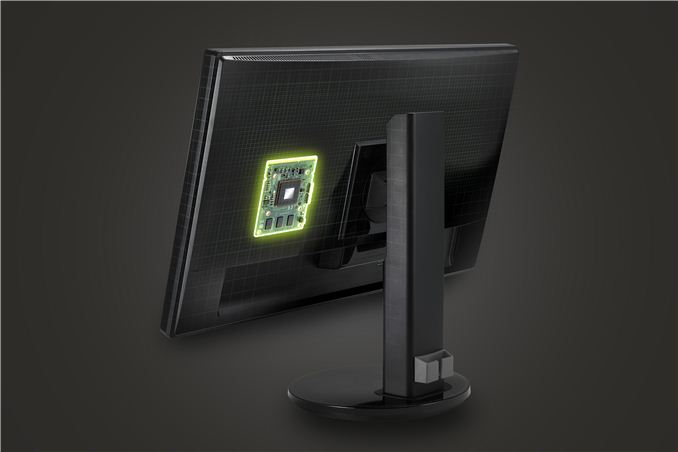
Earlier today NVIDIA announced G-Sync, its variable refresh rate technology for displays. The basic premise is simple. Displays refresh themselves at a fixed interval, but GPUs render frames at a completely independent frame rate. The disconnect between the two is one source of stuttering. You can disable v-sync to try and work around it but the end result is at best tearing, but at worst stuttering and tearing.
NVIDIA's G-Sync is a combination of software and hardware technologies that allows a modern GeForce GPU to control a variable display refresh rate on a monitor equipped with a G-Sync module. In traditional setups a display will refresh the screen at a fixed interval, but in a G-Sync enabled setup the display won't refresh the screen until it's given a new frame from the GPU.
NVIDIA demonstrated the technology on 144Hz ASUS panels, which obviously caps the max GPU present rate at 144 fps although that's not a limit of G-Sync. There's a lower bound of 30Hz as well, since anything below that and you'll begin to run into issues with flickering. If the frame rate drops below 30 fps, the display will present duplicates of each frame.
There's a bunch of other work done on the G-Sync module side to deal with some funny effects of LCDs when driven asynchronously. NVIDIA wouldn't go into great detail other than to say that there are considerations that need to be taken into account.
The first native G-Sync enabled monitors won't show up until Q1 next year, however NVIDIA will be releasing the G-Sync board for modding before the end of this year. Initially supporting Asus’s VG248QE monitor, end-users will be able to mod their monitor to install the board, or alternatively professional modders will be selling pre-modified monitors. Otherwise in Q1 of next year ASUS will be selling the VG248QE with the G-Sync board built in for $399, while BenQ, Philips, and ViewSonic are also committing to rolling out their own G-Sync equipped monitors next year too. I'm hearing that NVIDIA wants to try and get the module down to below $100 eventually. The G-Sync module itself looks like this:
There's a controller and at least 3 x 256MB memory devices on the board, although I'm guessing there's more on the back of the board. NVIDIA isn't giving us a lot of detail here so we'll have to deal with just a shot of the board for now.
Meanwhile we do have limited information on the interface itself; G-Sync is designed to work over DisplayPort (since it’s packet based), with NVIDIA manipulating the timing of the v-blank signal to indicate a refresh. Importantly, this indicates that NVIDIA may not be significantly modifying the DisplayPort protocol, which at least cracks open the door to other implementations on the source/video card side.
Although we only have limited information on the technology at this time, the good news is we got a bunch of cool demos of G-Sync at the event today. I'm going to have to describe most of what I saw since it's difficult to present this otherwise. NVIDIA had two identical systems configured with GeForce GTX 760s, both featured the same ASUS 144Hz displays but only one of them had NVIDIA's G-Sync module installed. NVIDIA ran through a couple of demos to show the benefits of G-Sync, and they were awesome.
The first demo was a swinging pendulum. NVIDIA's demo harness allows you to set min/max frame times, and for the initial test case we saw both systems running at a fixed 60 fps. The performance on both systems was identical as was the visual experience. I noticed no stuttering, and since v-sync was on there was no visible tearing either. Then things got interesting.
NVIDIA then dropped the frame rate on both systems down to 50 fps, once again static. The traditional system started to exhibit stuttering as we saw the effects of having a mismatched GPU frame rate and monitor refresh rate. Since the case itself was pathological in nature (you don't always have a constant mismatch between the two), the stuttering was extremely pronounced. The same demo on the g-sync system? Flawless, smooth.
NVIDIA then dropped the frame rate even more, down to an average of around 45 fps but also introduced variability in frame times, making the demo even more realistic. Once again, the traditional setup with v-sync enabled was a stuttering mess while the G-Sync system didn't skip a beat.
Next up was disabling v-sync with hopes of reducing stuttering, resulting in both stuttering (still refresh rate/fps mismatch) and now tearing. The G-Sync system, once again, handled the test case perfectly. It delivered the same smoothness and visual experience as if the we were looking at a game rendering perfectly at a constant 60 fps. It's sort of ridiculous and completely changes the overall user experience. Drops in frame rate no longer have to be drops in smoothness. Game devs relying on the presence of G-Sync can throw higher quality effects at a scene since they don't need to be as afraid of drops in frame rate excursions below 60 fps.
Switching gears NVIDIA also ran a real world demonstration by spinning the camera around Lara Croft in Tomb Raider. The stutter/tearing effects weren't as pronounced as in NVIDIA's test case, but they were both definitely present on the traditional system and completely absent on the G-Sync machine. I can't stress enough just how smooth the G-Sync experience was, it's a game changer.
The combination of technologies like GeForce Experience, having a ton of GPU performance and G-Sync can really work together to deliver a new level of smoothness, image quality and experience in games. We've seen a resurgence of PC gaming over the past few years, but G-Sync has the potential to take the PC gaming experience to a completely new level.
Update: NVIDIA has posted a bit more information about G-Sync, including the specs of the modified Asus VG248QE monitor, and the system requirements.
| NVIDIA G-Sync System Requirements | |||||||||
| Video Card | GeForce GTX 650 Ti Boost or Higher | ||||||||
| Display | G-Sync Equipped Display | ||||||||
| Driver | R331.58 or Higher | ||||||||
| Operating System | Windows 7/8/8.1 | ||||||||


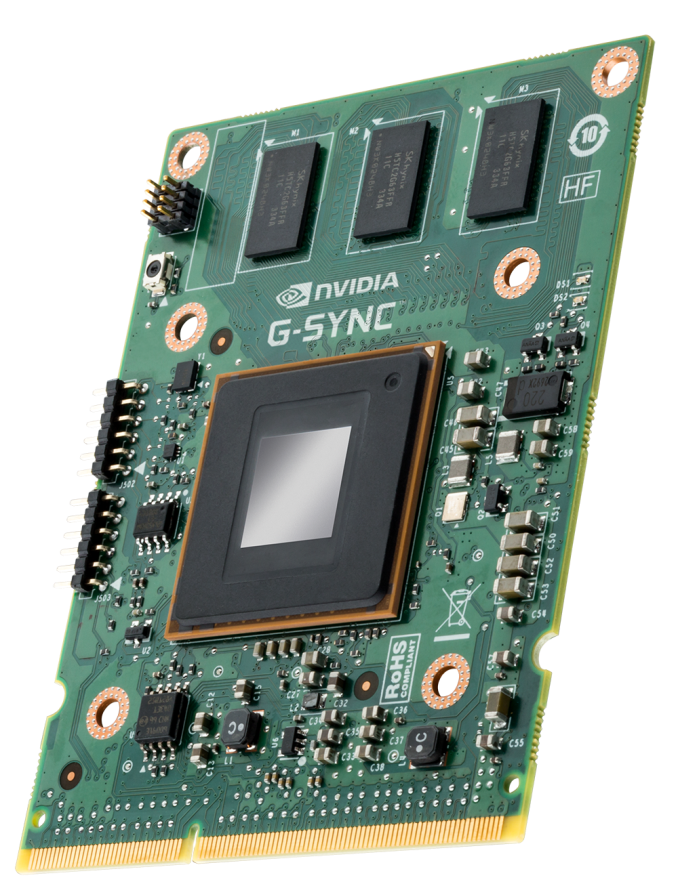
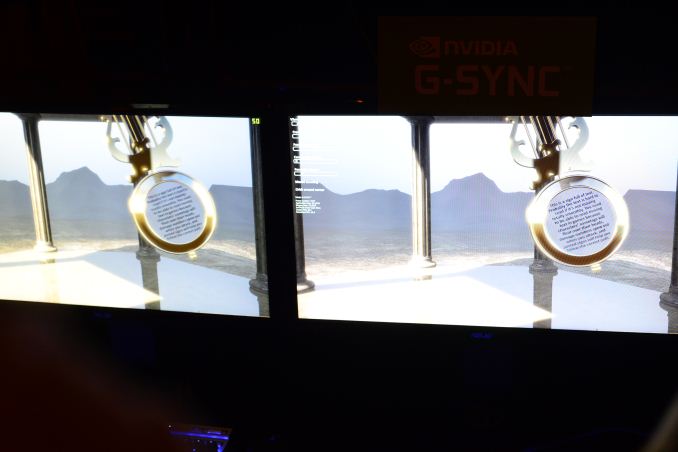
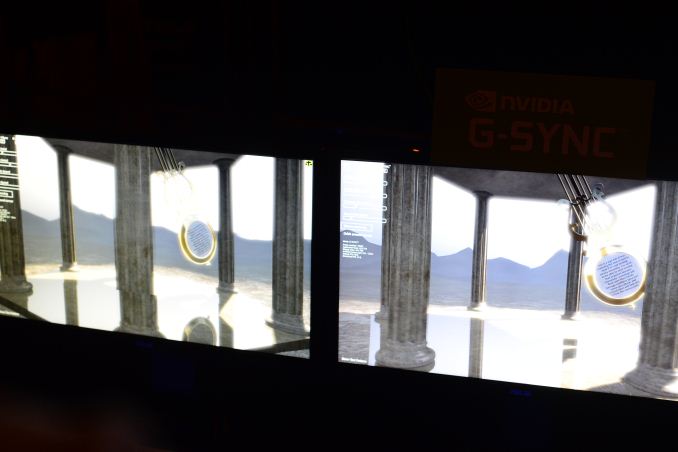

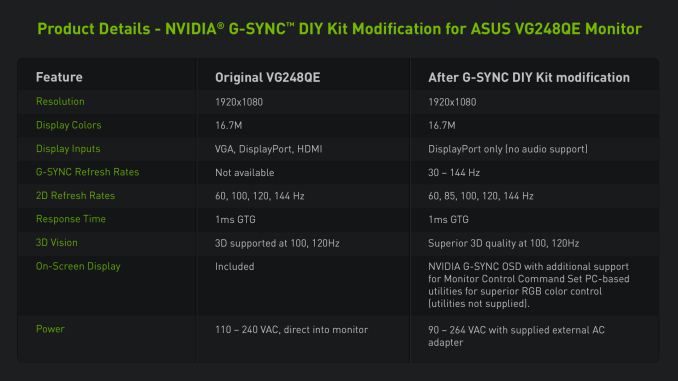








217 Comments
View All Comments
MrSpadge - Friday, October 18, 2013 - link
Yeah, if they're spending >100$ to make the refresh rate flexible they should also unstutter movies. With a lower limit of 30 Hz (which makes sense) they could display them as 2*23.976 Hz.madwolfa - Saturday, October 19, 2013 - link
I really stopped caring about it since madVR and its "Smooth Motion" function...looper - Friday, October 18, 2013 - link
Sounds very interesting.For the last month or so, I have been learning about nVidia cards using LightBoost with a group of 120 hz TN panel monitors. ( Esp. the Asus mentioned above, and the BenQ XL2420TE) The result is a big improvement in smoothness/accuracy, particularly in 'FPS' style games.
How does this new 'G Sync' feature come into this equation?
monitorsrock - Friday, October 18, 2013 - link
It looks like Overlord has been trying to get G-Sync expanded beyond just TN 1080 panels to their 1440 IPS 120hz monsters. GAWD. That is a wet dream for me - 1440 IPS 120Hz goodness with G-Sync? Yummy!repoman27 - Friday, October 18, 2013 - link
"NVIDIA demonstrated the technology on 144Hz ASUS panels, which obviously caps the max GPU present rate at 144 fps although that's not a limit of G-Sync."Well, unless G-Sync can make use of DisplayPort 1.2 HBR2, the maximum refresh rate for 1920x1080, 24 bpp under DP 1.1a is 149 Hz, or for any practical purposes 144 Hz. And for 2560x1440, 24 bpp, you're looking at a max of 88 Hz, or 85 Hz in practice.
I'm guessing that the GPU simply negotiates the maximum bitrate possible for the DP link, and then bit stuffs to accommodate lower frame rates.
Hrel - Friday, October 18, 2013 - link
This is cool, just like their streaming thing. But I don't care about vendor specific features. We shouldn't be trying to further segregate the market, we should be working on open source, multi-platform tools. Like OpenGL. How have people not learned that proprietary features are bad for the industry at large? It's so obvious.A5 - Friday, October 18, 2013 - link
Proprietary features like this pop up pretty regularly. I'll be surprised if this particular version gains any traction, but maybe there will be a standard-ish version of it in a future revision of the DisplayPort spec...willis936 - Friday, October 18, 2013 - link
So will this be completely transparent if you have a supported monitor and GPU? As in will this benefit media playback that's traditionally at 23.976 fps?Moreover what is the GPU requirement? Does this need kepler (600+ series)? Could this be used in conjunction with wireless streaming services (shield included) for living room (aka TVs that won't support G-Sync)?
Also how much will that mod board cost? I'd love to throw that in my Dell IPS and it'd be a good learning experience. I'm on a 500 series GPU so if it requires kepler there'd be no reason to mod before I upgrade (planning maxwell). By that point there should be many mod guides around.
Friendly0Fire - Friday, October 18, 2013 - link
The live blog posted earlier said this was Kepler and above only. I'm guessing this is largely targeted at games, but could be adapted to GPU-accelerated movie playback.I very much doubt this tech would do anything for wireless streaming; there's an order of magnitude more latency in sending the video feed over wifi than anything related to v-sync.
SleepyFE - Friday, October 18, 2013 - link
That's all fine and good (didn't read all the comments, but there are few bad ones on AnandTech) but it costs as much as another graphics card, so is it worth it?And why don't they try to match the GPU processing to the monitor frame rate and see how that goes (an you only need to update the driver)?